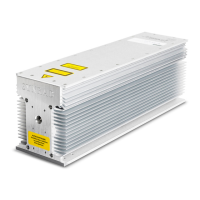technical reference
77
SYNRAD OEM v40 Operator’s Manual Version 4
Integrating Firestar safety features
The Integrating Firestar safety features section includes subsections:
■ Keyswitch functions
■ Shutter functions
■ Remote Interlock functions
Firestar’s User I/O connector allows system integrators or end-users to integrate Firestar safety features into
their control system. Firestar’s keyswitch, shutter, and remote interlock functions serve to enable or disable
DC power to Firestar’s RF drive. Without power, the RF driver cannot supply PWM Command or tickle
signals to the resonator, causing the CO
2
gas to remain in a zero-energy state. Firestar status indicators
provide users with a quick visual indication of the laser’s operational status. All power to the RF board is
removed whenever RDY or SHT indicators are O. (Laser Ready or Shutter Open outputs open).
Keyswitch functions
Keyswitch lasers
After DC power-up or after a remote interlock fault, the Keyswitch must be toggled to reset the laser and
enable the RDY LED, signaling that DC power is applied to the RF driver. Over temperature faults are
reset by removing, then reapplying DC power after the laser has cooled.
For Keyswitch lasers used in automated systems, this reset function is provided by the Remote Reset/
Start Request signal via Pin 2 on the User I/O connector. To use this “remote keyswitch” functionality,
rst place the Keyswitch in the ON position. To reset a fault condition, apply a ±5–24 VDC signal to Pin
2, Remote Reset/Start Request, and Pin 11, Input Common. Removing the signal applies power to the
RF driver causing the RDY lamp to illuminate and begins a ve-second countdown after which lasing is
enabled. The RF driver is disabled as long as a ±5–24 VDC signal is applied to Pin 2.
Your control system can monitor the laser’s ready status on the User I/O connector by connecting your
system’s input to Pin 8, Laser Ready, and Pin 13, Output Common (see output driving PLC input module
Figure 4-16). The Laser Ready output closes when the laser is enabled (RDY LED illuminated yellow),
indicating that lasing is possible. The output is open (RDY LED o) when lasing is disabled.
Note: A ve-second delay occurs between the time the Laser Ready output closes and lasing is
enabled.
OEM lasers
On OEM lasers, the RDY LED illuminates on DC power-up (provided that Shutter Open Request and
Remote Interlock inputs are enabled) and ve seconds later DC power is applied to the RF driver. Over
temperature faults are reset by removing and then reapplying DC power after the laser has cooled. Remote
interlock faults are not latched; the RDY LED illuminates yellow as soon as the interlock circuit is closed
(when the INT LED turns from red to green) and ve seconds later lasing is enabled.
Although a Remote Reset/Start Request input is not needed to reset OEM faults, it can be used to
inhibit (disable) lasing. Disable the laser by applying a ±5–24 VDC signal to Pin 2, Remote Reset/Start
Request, and Pin 11, Input Common. Removing the signal applies power to the RF driver causing the
RDY lamp to illuminate and begins a ve-second countdown after which lasing is enabled. The RF driver
is disabled as long as a ±5–24 VDC Remote Reset/Start Request input is applied.
Your control system can monitor the laser’s ready status on the User I/O connector by connecting your
system’s input to Pin 8, Laser Ready, and Pin 13, Output Common (see prior table).

